College Lake
Don’t be intimidated by the length of the telescopic lenses and expectation you’ll need to be quiet and respectful towards the residents and other guests.
Once part of extensive mining and quarrying, College Lake is what is possible when a busy industrial site is transformed into a wildlife haven. The tiny molluscs, ammonites and sea creatures that swam in the subtropical sea that once covered southern England, sank to the ocean floor and over millennia, they added to the compacted layers that were to become the foundations of the Chiltern Hills: chalk.
The story of the Chilterns are in fact all about chalk; this geological formation defines our landscape, industry, people, wildlife and wildflowers. But it’s not all chocolate box imagery; quarrying for cement saw numerous sites across the region busy with extraction during the last century. Some still remain, others are filled with waste water or have been transformed, like College Lake into nature reserves, making them an ideal haven for wildflowers and wildlife.
Sunken into the landscape, the lake is perhaps more noticeable from the sky as flocks of gulls circle to feed overhead and pairs of noisy geese on their fly pasts.
There are resident ducks, warblers, and swans and many more migratory birds that overwinter and others that are starting to arrive as the season turns to spring. Resident cows and sheep are dotted about too.
This flagship reserve is managed by the Berks, Bucks and Oxon Wildlife Trust (BBOWT), but you don’t need to be a keen wildfowl spotter to enjoy the dramatic location and far-teaching views back towards the Chilterns and Ivinghoe Beacon.
It’s not just sharks and sea urchins that once swan in this ancient sea, the area was transformed into Savannah about 200,000 years ago and in 1982 mammoth tusks and teeth were found. They are on display in the shop.
I like to find out the origin of place names, but they can sometimes raise more questions than answers: College Lake is named after College Farm that in turn took its name from Trinity College Cambridge, which once owned the land. If you know why, please share.
The circular trail is a leisurely stroll around the lake, passing bird hides, gently rusting bits of agricultural and mining machinery, with plenty of places to stop and enjoy the surroundings.
There’s a shop selling all manner of countryside goods and wildlife accessories. The cafe can get overwhelmed with the queue for coffee so I’ll be bringing a picnic the next time I visit. Open all year, entrance is free and no dogs allowed.
Unless otherwise stated, all images and content are copyright of Mary Tebje.
Links you will need
Information on access and visiting times to College Lake. Download the map and three walking trails here.
Tales of medieval mischief and miracles on the intriguing Tring Tiles, rescued from the scap heap now on display in the British Museum.
The story of the Chilterns are in fact all about chalk; this geological formation defines our landscape, industry, people, wildlife and wildflowers. What did the great ooze ever do for us?




